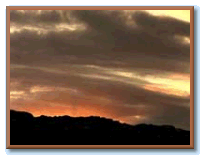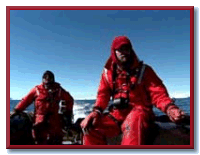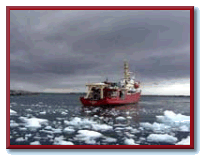|
From: Jefferson Elementary and Dr. Ralph Bovard,
Palmer Station. Over the past few months, Palmer's resident doctor, Dr. Ralph Bovard, has corresponded via e-mail with students from the 5th grade class taught by one of Ralph's old high school friends, Scott Peterson, and another 5th grade class taught by Scott's wife, Janet. These letters provide a fascinating portrait both of a place and a person, and also shows what interests young people about Antarctica and the unusual group of people who live and work there. Mason City, Iowa, is the River City of Meredith Wilson's "Music Man" and Ralph's hometown. Ralph's folks still live there. His family lives up at Clear Lake in the summers which is where Buddy Holly played his last gig with the Big Bopper and Richie Valens before they were killed in a plane crash in February 1959. Some of these letters served double duty going both to family and the 5th grade class. P.S. We really will try to find out why Ralph has the nom d'email, Dogear (or is it Doggear?) ***
Date: Thu, 14 Nov 1996 14:54:47 +0000 Dear Dr. Bovard, (Teacher Scott Petersen introduces the letter: Ralphy Boy... the following is a letter the students composed as a class. Each week I'm having a team of 4 students write and e-mail you. They think this is pretty neat. So do I.) Snow fell for the first time in Mason City yesterday. We only got about an inch, but it was a very pretty snowfall. The temperature has been in the low 20's the past few days...it's supposed to warm up this weekend.
What are your days and nights like? Temperature?
Thanks for the information, *** Subject: Report to Jefferson Fifth Grade Class Date: Sun, 17 Nov 1996 21:16:48 -0500 Greetings from the South, Thank you all for the wonderful letters. I very much enjoyed them and read them at dinner the other day. The other folks on station enjoyed them too. I don't want to answer all your questions at once, so we will have to "dole" (note clever use of a vocabulary word recently in political news) out the information bit by bit. Anyway, sounds as if you are freezing up there! It has been very pleasant here. The coldest it has ever been at Palmer Station is -15 Farenheit...not as cold as Iowa. Lately it has been 32-40 degrees F; but we do our recordings in centigrade, so 0 to 5 C. Pretty balmy. The last week or so has been very sunny and the winds calm. Typically there is at least some cloud cover 28/30 days of the month. Several weeks ago we had a week with gusts of 50-60 knot winds. Sailors use the measure of knots for wind and boat speed instead of regular miles per hour for a specific reason. Namely because the Earth is divided into degrees of longitude and latitude for measurement. One degree equals 60 "nautical" miles; and a nautical mile is slightly longer than a normal mile. The speed unit of knots should actually be nauts because it is nautical miles per hour. One nautical mile is about 1.1 regular miles;so it is bigger than a regular mile and a 10 knot wind (actually about 11mph) is faster than a 10 mph wind. It may seem confusing but it is just a different way of expressing concepts and is more useful for sailors and folks who work at sea. All over the world are different people saying similar things in different languages, wearing different clothes, with different religions... but all in all with pretty much the same needs and likes. All this variety is what makes it interesting. It is like an orchestra. If everybody played the same instrument, it wouldn't sound nearly so wonderful. OK, I am ranting. Days and nights here? It is the "Austral" (i.e. southern) summer here now. We are just the opposite of your season. It gets dusky at night, and the sun does go beneath the horizon, but never completely dark. Down at the true South Pole it will be light 24 hours a day; but that also means that during their winter it is actually totally dark 24 hours a day as well.
Our work schedule is 7:30 am until 5:30 pm with 1 hour for lunch and two 20 min breaks, one each in the morning and the afternoon. I open the store on Monday and Wednesday evenings for 2 hours, and during supper on Saturday. We work 6 days a week formally. Of course if there are any emergencies, whether medical or plumbing or electrical or if there were a fire, everyone has to be able to help at any time of day. There are 43 personnel here on station at present. 25 are employed by Antarctic Support Associates (henceforth abbreviated ASA) in Denver (of which I am one) and 18 are scientists here under NSF (ie National Science Foundation) research grants. We "support" the scientists in their work, provide the environment for them to study the animals, birds, ocean, and air. This station, just as the big McMurdo station on the Ross Ice shelf and the small true South Pole station exist for the scientific studies. Otherwise we wouldn't be here.
Clothing? Usually I wear a t-shirt or knit shirt and blue-jeans or Carhart jeans (the clothing of choice here). It is heated inside and walking between buildings is no problem. Don't need a coat for that. When we hike up the glacier we wear skis, or snowshoes, and fleece and windjackets. But when someone goes out in a Zodiac inflatable boat (2 sizes: one holds 4 people and the other up to 7 people with 45 hp outboard motors and a spare motor in every boat) we wear special Mustang "float" coats or full body insulated fluorescent orange coveralls. If one fell in the water or the boat sank or overturned, one probably wouldnt survive for more that 20 minutes. The water temperature is -1 C (30 degrees F)! You cool much faster in the water due to "convection" than in the air. There are two kinds of ice in the water. Ice that comes from the sea water freezing which occurs at about -4 d. C and ice that falls off glaciers and icebergs into the sea. The sea ice floats about and is pushed all over the surface by the wind. It is called "grease" ice when it is just forming, "pancake" ice in small floes, "brash"ice when it starts getting congested into chunks, and "pack" ice when bigger floes get pushed together to prevent passage. Somedays you wake up and the harbour is full of pack ice pushed in from the sea by the wind; it may stay a week then you wake up the next day and it is gone. It can be centimeters thick or feet thick. Our island (Anvers) is completely covered by a glacier 40 by 70 kilometers long. Big icebergs fall off into the sea all the time. Very spectacular. We had a medical emergency last week. A young woman scientist who had just arrived on the icebreaker, Polar Duke (209 feet long) came to see me because she had abdominal pain... which is not a good thing. Unfortunately, her pain made me think she was having a case of acute appendicitis, so we had had to evacuate her to Chile for more specialized hospital/surgical evaluation and care.
The problem was how to get her there. It had taken the ship 5 days to get here steaming across the Drake Passage; and it would take that long to get back. Not to mention that all the scientists on the ship were planning to do 30 days of research, and that evacuation method would deny them 10 days of work. Fortunately we were able to get authorization for a British airplane called a Twin Otter to fly here from Rothera base on Adelaide Island (200 miles to the south) who picked her up and then flew her to Chile. The trip took about 8 hours after they had put special gas tanks in the plane for the 800 mile crossing. She had surgery the next day and is doing well at last report. (Ed. note: See Mary Lenox's Journal for more on the MEDEVAC flight and how it was achieved.) Otherwise I see about 10 patients per week for various things. Nothing too serious so far... knock on wood, but the day is very busy with all sorts of managerial, inventory, stocking, ordering, and maintenance sorts of things to do. If I get hurt? Then the carpenter and the boat mechanic get to practice. We will save a few things like where we sleep, live, who comes to visit, what we eat, and "what animals are roaming loose" for later, ok? Off to dinner. Again thanks for your letters. I may not be able to write this much every week, but will do my best to answer your questions. You can tell me about how the Mohawks are doing in different sports and what the weather is like. Anything you have that is news or interesting to you (plural) is great. Oh, I have to announce one result of the past election, of which I am very proud, and that is that the Honorable G. K. Bovard, otherwise known as the "Old Crow" and my pa, was re-elected to serve as a state district court judge for another 6 years. So mind yer p's and q's or ya may git throwed to the crocodiles!
Later,'Gators, |
||||||||
| Back to Field Journals Menu | Back to Dr. Ralph Bovard's Journals | Pen Pal Dog Ear | ||||||
![]()


